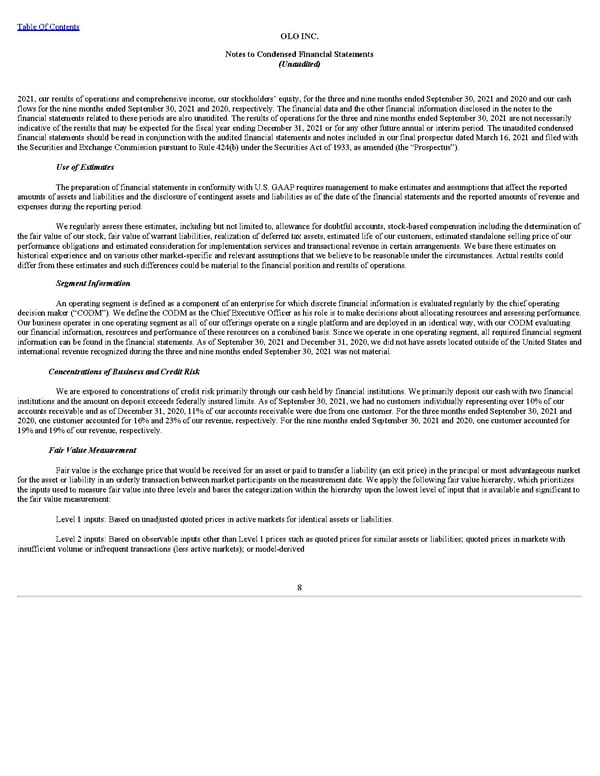Table Of Contents OLO INC. Notes to Condensed Financial Statements (Unaudited) 2021, our results of operations and comprehensive income, our stockholders’ equity, for the three and nine months ended September 30, 2021 and 2020 and our cash flows for the nine months ended September 30, 2021 and 2020, respectively. The financial data and the other financial information disclosed in the notes to the financial statements related to these periods are also unaudited. The results of operations for the three and nine months ended September 30, 2021 are not necessarily indicative of the results that may be expected for the fiscal year ending December 31, 2021 or for any other future annual or interim period. The unaudited condensed financial statements should be read in conjunction with the audited financial statements and notes included in our final prospectus dated March 16, 2021 and filed with the Securities and Exchange Commission pursuant to Rule 424(b) under the Securities Act of 1933, as amended (the “Prospectus”). Use of Estimates The preparation of financial statements in conformity with U.S. GAAP requires management to make estimates and assumptions that affect the reported amounts of assets and liabilities and the disclosure of contingent assets and liabilities as of the date of the financial statements and the reported amounts of revenue and expenses during the reporting period. We regularly assess these estimates, including but not limited to, allowance for doubtful accounts, stock-based compensation including the determination of the fair value of our stock, fair value of warrant liabilities, realization of deferred tax assets, estimated life of our customers, estimated standalone selling price of our performance obligations and estimated consideration for implementation services and transactional revenue in certain arrangements. We base these estimates on historical experience and on various other market-specific and relevant assumptions that we believe to be reasonable under the circumstances. Actual results could differ from these estimates and such differences could be material to the financial position and results of operations. Segment Information An operating segment is defined as a component of an enterprise for which discrete financial information is evaluated regularly by the chief operating decision maker (“CODM”). We define the CODM as the Chief Executive Officer as his role is to make decisions about allocating resources and assessing performance. Our business operates in one operating segment as all of our offerings operate on a single platform and are deployed in an identical way, with our CODM evaluating our financial information, resources and performance of these resources on a combined basis. Since we operate in one operating segment, all required financial segment information can be found in the financial statements. As of September 30, 2021 and December 31, 2020, we did not have assets located outside of the United States and international revenue recognized during the three and nine months ended September 30, 2021 was not material. Concentrations of Business and Credit Risk We are exposed to concentrations of credit risk primarily through our cash held by financial institutions. We primarily deposit our cash with two financial institutions and the amount on deposit exceeds federally insured limits. As of September 30, 2021, we had no customers individually representing over 10% of our accounts receivable and as of December 31, 2020, 11% of our accounts receivable were due from one customer. For the three months ended September 30, 2021 and 2020, one customer accounted for 16% and 23% of our revenue, respectively. For the nine months ended September 30, 2021 and 2020, one customer accounted for 19% and 19% of our revenue, respectively. Fair Value Measurement Fair value is the exchange price that would be received for an asset or paid to transfer a liability (an exit price) in the principal or most advantageous market for the asset or liability in an orderly transaction between market participants on the measurement date. We apply the following fair value hierarchy, which prioritizes the inputs used to measure fair value into three levels and bases the categorization within the hierarchy upon the lowest level of input that is available and significant to the fair value measurement: Level 1 inputs: Based on unadjusted quoted prices in active markets for identical assets or liabilities. Level 2 inputs: Based on observable inputs other than Level 1 prices such as quoted prices for similar assets or liabilities; quoted prices in markets with insufficient volume or infrequent transactions (less active markets); or model-derived 8
 Q3 2021 10Q Page 13 Page 15
Q3 2021 10Q Page 13 Page 15